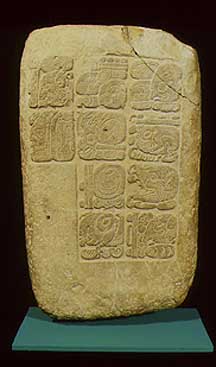The Search for Site Q
 The quest for a lost Maya city, known only as Site Q (Spanish for “ ¿que? ” or “which ”), began in the 1970s. Peter Mathews, a Yale graduate student, noticed that inscriptions found on many monuments in museums and private collections shared similar graphic features. Not only did some of the monuments appear to have been connected at one time, they also were all carved from a marble-like limestone that may have come from a single source.
The quest for a lost Maya city, known only as Site Q (Spanish for “ ¿que? ” or “which ”), began in the 1970s. Peter Mathews, a Yale graduate student, noticed that inscriptions found on many monuments in museums and private collections shared similar graphic features. Not only did some of the monuments appear to have been connected at one time, they also were all carved from a marble-like limestone that may have come from a single source.
Over the years many ancient Maya cities have been proposed as the possible location of Site Q. Ian Graham and David Stuart, archaeologists at Harvard University’s Peabody Museum, speculated that the source of the Maya monuments, carved in the eighth century A.D., possibly lay along the Usumacinta River between Guatemala and Mexico. Archaeologists could not be sure of the location because there was no documentation of any kind about the removal of the monuments from the original site.
Recently, new information has come to light to help identify Site Q. In 1997 a NASA satellite pinpointed an undocumented site deep in the jungle of Guatemala. Archaeologists know this site as La Corona. In a visit to La Corona, Ian Graham and David Stuart found that the site was badly looted. Scattered mounds in thick jungle were all that remained. The main plaza, about the size of a football field, was located between two acropolis structures and a row of five small temple mounds. Looters had left only gaping trenches, broken pots, and a few carved limestone panels, all very eroded. An incomplete stela far from the plaza caused great excitement. Engraved on its surface were glyphs read as “Red Turkey.” From a Site Q panel at the Art Institute of Chicago, “Red Turkey” was known to be the name of a local ruler and ballplayer.
Could La Corona be Site Q? Graham and Stuart turned to science to test the theory. Stuart asked to remove a small stone sample from the Hudson Museum’s Site Q panel. The sample would be compared to 19 other samples of limestone from La Corona and other Maya sites. An expedition collected the Guatemalan samples in August of 2000. Granite Productions documented the process of gathering the samples for British television. Dr. Chris Hayward of the University of Manchester in England compared the samples by using stable isotope and petrographic analyses. One La Corona sample was a close match to the Hudson Museum sample, providing some support for identifying La Corona as Site Q.
For more information about Site Q, visit the Online Features at Archaeology magazine.
